
Portable air conditioners are a versatile and convenient way to stay comfortable in various settings, from homes without central AC to offices, dorm rooms, and even outdoor spaces. But have you ever wondered how these compact cooling units actually work their magic? Let’s take a closer look.
- Air Circulation: Portable air conditioners operate by drawing warm indoor air into the unit through an intake vent. This warm air contains heat and moisture that need to be removed to achieve cooling.
- Cooling Coil: Inside the portable AC, there’s a cooling coil filled with a refrigerant, typically a hydrochlorofluorocarbon (HCFC) or hydrofluorocarbon (HFC). This refrigerant is responsible for absorbing heat from the incoming warm air.
- Refrigeration Cycle: The refrigeration cycle begins as the warm air passes over the cooling coil. The refrigerant inside the coil evaporates, absorbing heat energy from the air and turning into a gas. This process cools the air.
- Condensation: The hot, gaseous refrigerant is then pumped outside of the unit to a condenser coil. Here, the refrigerant releases the heat it absorbed from the indoor air, causing it to condense back into a liquid state.
- Hot Air Exhaust: As the refrigerant condenses, it releases heat, which is expelled from the portable AC through an exhaust hose or vent. This hose is typically placed near a window or through an opening to ensure the hot air is directed outside.
- Return Air: The now-cooled air is recirculated into the room through a separate vent, helping to lower the indoor temperature.
- Dehumidification: In addition to cooling, portable AC units also dehumidify the air. As warm air passes over the cooling coil, moisture in the air condenses and is collected in a reservoir or drained away.
- Temperature Control: Users can set their desired temperature on the portable AC unit. The device continually cycles warm air in and cool air out until the desired temperature is achieved.
- Portability: The “portable” aspect comes from the unit’s mobility. These ACs are equipped with wheels for easy movement from room to room, making them a flexible cooling solution.

It’s important to note that while portable air conditioners can effectively cool smaller spaces, they may not be as efficient as central air conditioning systems for cooling larger areas. Additionally, proper venting is crucial for their performance, as they need a way to exhaust hot air outside.
How Portable Air Conditioners Work
Let us now look at how portable air conditioners work in more details. The fact of the matter is that portable ACs work just like the other types of air conditioners albeit with some differences.
One of the main and notable differences between portable and other types of air conditioners is that portable AC units are compact units with all the components of the AC housed together, and is always installed inside the house.
Other types of air conditioners have an indoor and outside unit. The indoor unit is responsible for absorbing heat from the indoor air while the outside unit is for releasing the heat to the outside air.
Just like the other types of air conditioners, a portable air conditioner is made up of the following components:
- Evaporator coil
- Compressor
- Condenser coil
- Fan
- Refrigerant
The following is a process of how hot indoor air is cooled by the portable AC unit:
1. Warm Air is Pulled towards the Unit
When the portable air conditioning unit kicks in, the fan starts by pulling the warm and humid air from the room towards it. The air is fast passed through an air filter to remove impurities from the air like dust, hair, far, dander, lint, pollen etc.
The air filter needs to be cleaned regularly to prevent it from clogging up which restricts the flow of air to the evaporator coil. That can cause the evaporator coil to freeze and fail to work. A dirty filter also causes the fan to overwork, increasing you energy bills.
2. Cooling and Dehumidification
The evaporator coil is the first coil that the hot and humid air encounters. It is usually filled with a cold fluid known as a refrigerant/coolant/Freon.
A refrigerant is an ideal fluid for this purpose since it has a low boiling point (changes from liquid to gas at low temperatures) and when it evaporates it takes away with it a lot of heat. That is why refrigerants are used in refrigeration and air conditioning.
When the warm and humid air comes into contact with the cold evaporator coil, 2 things happen:
- The air is cooled
- Water vapor condenses
As the air is passing through the coil, the refrigerant absorbs heat from the air and that is how the indoor air is cooled. The fan also helps to circulate the now cooled air back to the room.
As you know, when water vapor is introduced to low temperatures, it condenses back to liquid water. And that is exactly what happens.
Upon contact with the coil, the moisture in the air condenses and the water drips down to a condensate tank at the bottom of the unit. That is how portable air conditioners reduce humidity in the house.
3. Draining Water out of the Portable Air Conditioner
As I have mentioned, portable air conditioners have a bucket/tank where the condensate drains into. The water needs to be emptied otherwise once the tank is full the unit will turn off to prevent more condensation and water overflowing out of the unit.
That however depends on the type of portable AC unit. There are 3 types of portable air conditions depending on how they drain water from the condensate tank:
Collection Bucket/Tank
With these units, which are the old models of portable ACs (and I wouldn’t recommend buying them), water accumulates inside an internal bucket which needs to be manually emptied.
The frequency of emptying the bucket depends on the relative humidity of where you live, the temperature settings and the rate of usage. Folks in humid places like Florida will need to empty theirs after every few hours but in dry areas like Arizona they can go for weeks before needing emptying.
Gravity Drain
As their name suggests, gravity drain portable air conditioners drain the water from the tanks via gravity. They may or may not have a built-in condensate pump which helps to pump out the water.
If your unit does not have a condensate pump, you may need to install it in an elevated place like on top of a stool or drain them directly in a floor drain.
If you don’t have a floor drain nearby, you may need to buy a condensate pump so that you can pump the water elsewhere like outside through the window.
Self-Evaporating Units
The third type which are also my favorite type of portable air conditioners are self-evaporating units. As their name suggests, these units have a mechanism to evaporate the condensate and then exhaust the vapor through the same hose used to exhaust hot gases.
I like these units since they are almost hands-free. Once the unit is installed you don’t have to keep worrying about manually emptying the tank every now and then, especially if you live in a humid area.
4. Compression of the Refrigerant
After absorbing heat from the indoor air, the refrigerant vaporizes (turns from liquid to gas) and flows out of the evaporator coil and enters the compressor.
The function of a compressor is an easy one but vital. It compresses the refrigerant gas which not only increases its pressure but its temperature as well. Increasing the temperature of the refrigerant creates a huge temperature differential between it and the surrounding air allowing it to lose the heat.
5. Removing Heat from the Refrigerant
From the compressor, the refrigerant gas enters the condenser coil which looks just like the evaporator coil. As the refrigerant is flowing through the condenser coil. The fan will be blowing cooler air across it.
The result of this process is that the air will absorb heat from the refrigerant and get exhausted through the window with the help of a hose connected to the rear of the unit.
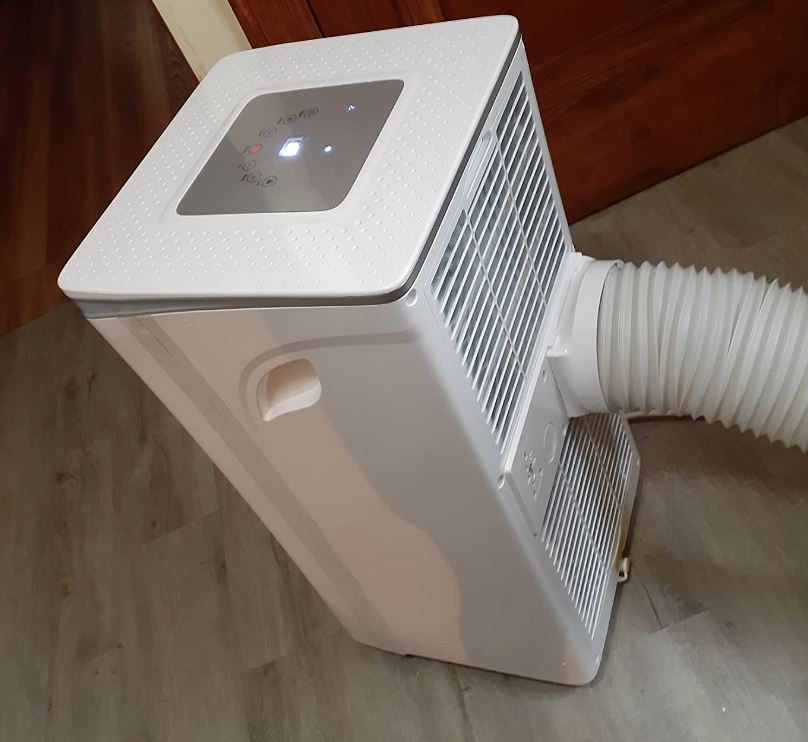
The process of removing heat from the refrigerant and disposing it is one of the pain points for portable ACs, unlike other AC systems which have an outside unit. This process also makes portable ACs not so energy-efficient.
Anyway, by the time the refrigerant is coming out of the other end of the condenser coil, it will have lost so much heat that it will have condensed back to its liquid state. It will also be forced through an expansion valve to further reduce its pressure and temperature.
At that point, the refrigerant will be ready to go back to the evaporator coil for another round of cooling. As you can tell, the refrigerant flows through a closed-loop system which helps it to effect heat exchange.
And basically that is how a portable air conditioner works.
Single vs Dual-Hose Portable Air Conditioners
One thing that you will need to decide early on when buying a portable air conditioner is if you want a single-hose or a dual-hose AC unit. What is the difference?
Single-Hose Portable Air Conditioners.
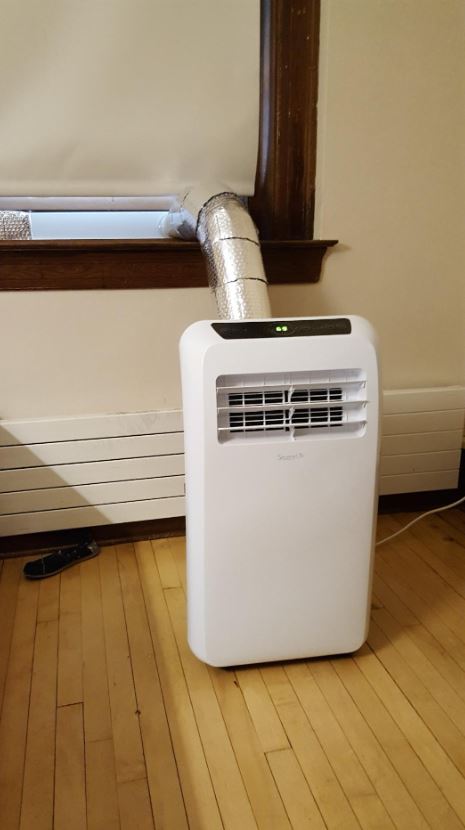
As its name suggests, single-hose portable air conditioners have only one hose to vent out hot air from the unit to the outside of the house. That can be a problem in how effective the unit is.
A single-hose portable AC unit pulls air from the room for both cooling and to also help the condenser coil to remove heat from the refrigerant (basically cool the condenser coil).
When air is pulled by the unit from the room, negative air pressure maybe created since there is no way of immediately replacing the lost air. That forces air to infiltrate the room from outside through door or window gaps.
The effect of that is the unit will need to work hard to cool the air which reduces its efficiency. You may then have to keep all doors locked and possibly have the room insulated.
Dual-Hose Portable Air Conditioners
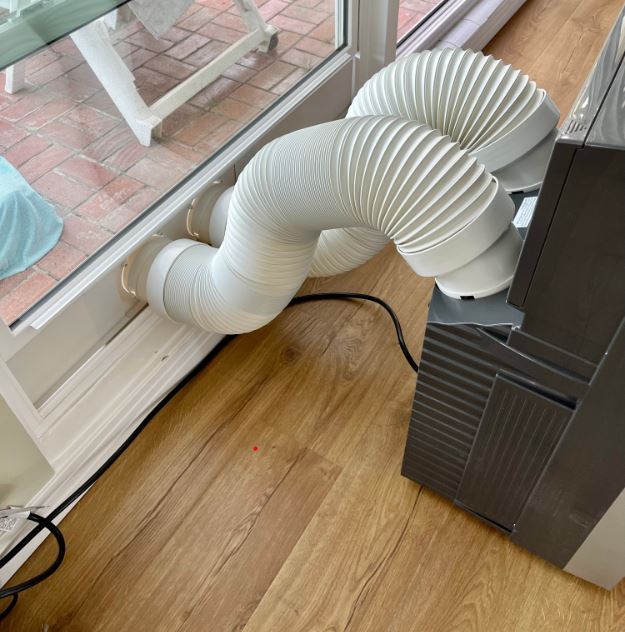
Dual-hose portable air conditioners have 2 hoses. One hose is for removing hot air and moisture from the unit to the outside while the other one is for bringing outside air in the unit.
This helps to create air balance. As the unit pulls air from outside, the secondary hose replaces it instantly and thus there is no creation of negative air in the room.
The outside air is not directly blown in the house though. It is first cooled down to the set temperatures. Most of the times the 2 hoses are combined together to look as one (for aesthetics) and is not easy to tell them apart from single-hose units.
Dual-hose portable air conditioners are more expensive and harder to install than single-hose portable air conditioners but they are more efficient and also bring in fresh air from outside.
Do All Portable Air Conditioners Have to be Vented Out through a Window?
Portable air conditioners are usually vented out through a window but they don’t always have to. It is just that a window is so practical for that purpose.
There are other instances when venting a portable AC through the window is impossible and in those cases there are other ways to do it. Some may need to be undertaken by an HVAC professional.
The first way to vent a portable air conditioner without a window is through a door. That works well especially when if it is a sliding door since you only need to buy the seal kit for it.
Ideally, the door needs to be leading to the outside, but not another room which means that you will transferring heat from one room to another.
Another way of venting a portable air conditioner without a window is through the wall. That means that you have to drill a large hole on the wall (similar in size with the exhaust hose).
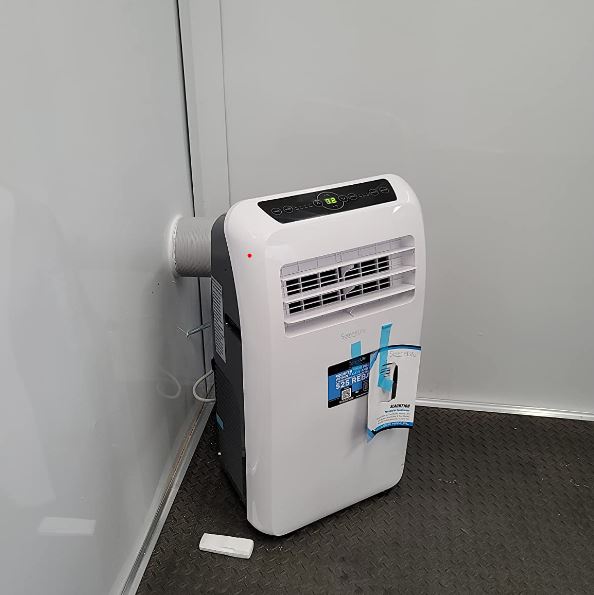
It is important to first ensure that the point you intend to drill the hole through has no water lines or other pipes running through it. The wall also needs to be fairly easy to drill through. If you are not sure about it I would suggest hiring a professional to do it for you.
Another decent way to vent a portable AC is through the dryer vent. The window seal kits which portable ACs come with are enough to vent the unit through the dryer vent.
The disadvantage with this method is that the dryer vent can be far away from where you want to install the air conditioner. You can buy a longer hose for that but to some people that will be an eyesore.
Portable air conditioners can also be vented through the ceiling. If your house has a drop ceiling, venting the unit through the ceiling is an easy and practical method.
Lastly, you can opt to buy a ventless portable air conditioner. I should start by mentioning that ventless portable air conditions are not air conditioners in the real sense and are actually known as evaporative coolers or swamp coolers
Evaporative coolers use cold water to cool the indoor air. These units are however not the best options for humid climates and should ideal be purchased by homeowners in dry areas where humidity is not a big concern.
Can You Just Plug in a Portable Air Conditioner?
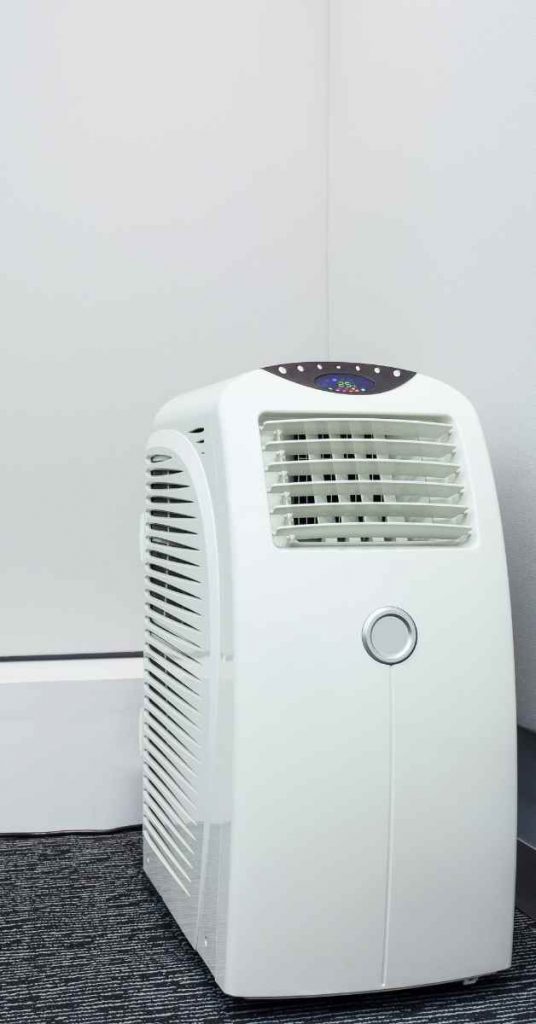
Air conditioners work by removing heat from the indoor heat and releasing it to the outside. That is why other air conditioners have an outside unit while portable air conditioners are vented out.
If you just plug in the air conditioner to the power outlet, can it still cool the room? Or what would happen if you just plugged in the portable AC?
If you use your portable air conditioner without venting it, it will run like a faulty a dehumidifier. As you know, dehumidifiers are excellent in removing humidity from the air but don’t cool the air.
On the other hand, a portable air conditioner without a vent will not dehumidify and neither will it cool the air. As a matter of fact, it can make the indoor air hotter than it actually were in the beginning.
So, what should you do? Does it mean that portable air conditioners must be vented?
What you can do is set your portable air conditioner to “dehumidifier” mode. With this mode set, the portable AC will not lower the temperature of the indoor air but it will reduce the relative humidity.
I am sure you are familiar with the phrase “It’s not the heat, it’s the humidity”. That is because humidity makes it feel hotter than it actually is.
If you are struggling with high humidity in the house and the portable AC is not vented, you can just turn it on and set it to dehumidifier mode.
Pros and Cons of Portable Air Conditioners
Portable air conditioners have their advantages and disadvantages. Let us start with their advantages.
Pros
The following are the advantages of portable air conditioners:
1. Easy to Install
Compared to other types or air conditioners like window, ductless and central air conditioners, portable air conditioner are just so easy to install. You don’t even have to call an HVAC technician to install it for you.
In some cases like when you need to vent the unit in other places other than the window or when you are not strong enough to do it yourself, you may need help. Even then, the installation cost will be low compared to others.
2. They are Inexpensive
Portable air conditioners are the cheapest types of air conditioners out there. Although the cost depends on size and brand, they are generally cheaper compared to window conditioners which are their closest rivals.
3. Not an Eyesore
To be honest, window air conditioners don’t look good from inside the house and from the outside. Some neighborhoods even prohibit their installation. In plain language, they are an eyesore.
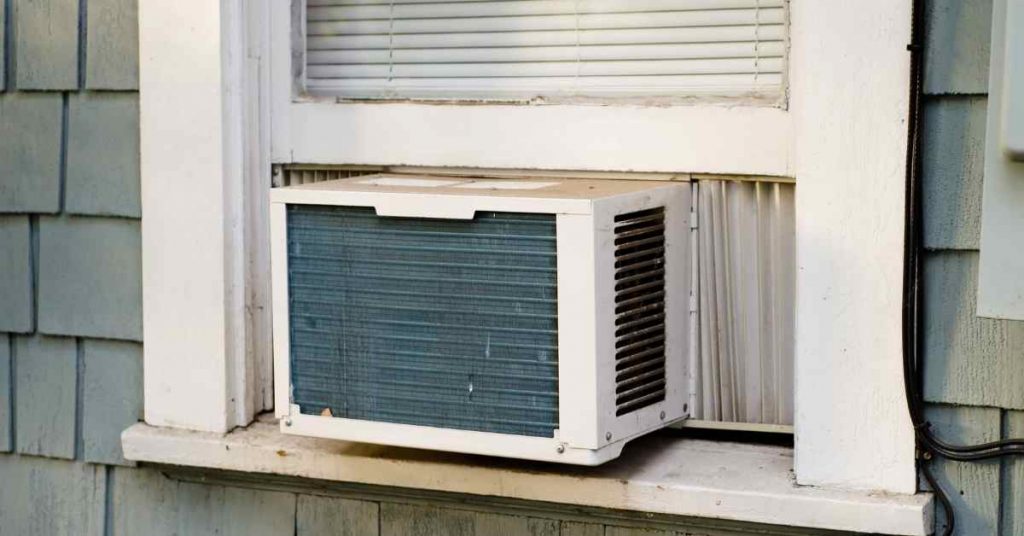
On the other hand, portable air conditioners don’t look that bad. I am sure you would prefer your bedroom without them but I don’t think they look as bad as window or wall-mounted air conditioners.
4. Easily Portable
One of the main advantages of portable air conditioners is their portability. You can move them through any room in the house with relative easy, since most also have wheels.
That is unlike window or other types of air conditioners which are permanently installed and if they have to be moved it involves too much work. Portable ACs unlike window units don’t have to be moved during winter to prevent them from freezing and getting damaged.
5. Best for Small Rooms
If you have a tiny house or a small room that is detached from the main house, a portable air conditioner comes in handy. It would be way expensive to install mini-split or window unit in such a place which makes the portable AC a great choice.
Cons of Portable Air Conditioners
Now, what are the disadvantages of portable air conditioners? The following are some of them:
1. They Need Floor Space
Portable air conditioners need to be installed on the floor and will thus occupy valuable floor space. If you hardly have space in your room or hate clatter, you should consider another option like a window AC.
2. They are Inefficient
Portable air conditioners are not the most energy-efficient ACs. They take longer to cooler the air in the room because as they cool the air, they also produce some heat in the process, forcing the unit to run for long thereby consuming more energy.
3. Need Regular Draining
Unless you buy a self-evaporating or gravity-drained portable energy conditioner, you will have to regularly and manually empty the condensate tank. Failure to do that the unit will turn off but it can also overflow and encourage mold growth.
4. They are Noisy
You need to be careful about the noisy levels of the portable AC you intend on buying. Generally, portable air conditioners are noisy but some are noisier than others.
The reason why portable AC units are noisier than other types of air conditioners is because all their components are located indoors. That is unlike other AC units which have an outside unit where some of the noisy is produced.
Do Portable Air Conditioners Work as Well as Window Units?
The short answer for this question is “No”! Window air conditioners cool a room better than a portable air conditioner. Apart from that, window units are also more energy-efficient.
As I mentioned earlier, the major pain point for portable air conditioners is venting the heat removed by the condenser coil to the outside. Their design makes it hard to exhaust all the heat and that is why it takes them longer to cool the air.
Single-hose portable air conditioners will also pool warm and humid air from outside the room which increases their overall inefficiency.
With window air conditioners, the condenser coil is located outside the house which means that the heat removed from the indoor air is dumped directly to the outside air. That makes the cooling process so fast and therefore efficient.
If performance and efficiency is important to you, you may need to consider a window AC unit. I have written about both air conditioners in length in this post.
Wrap Up
And basically that is everything about portable air conditioners and how they work. I hope that by now you know if you should buy one or not.





